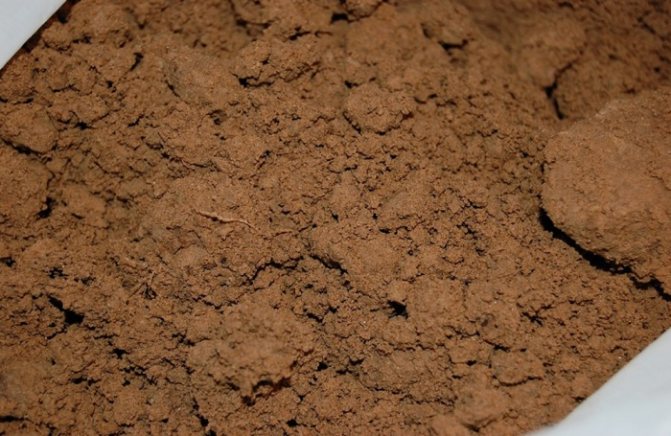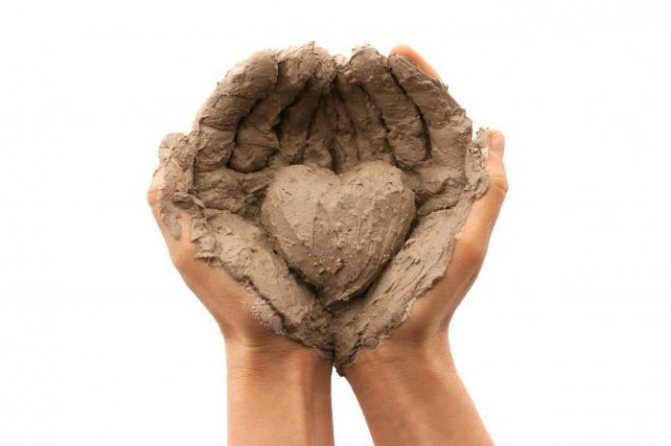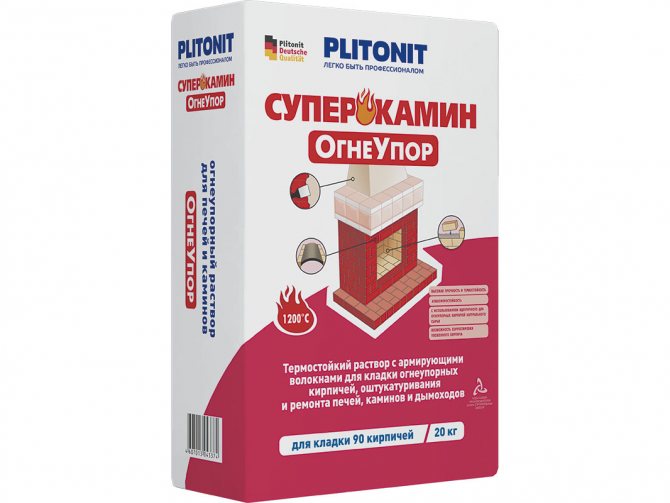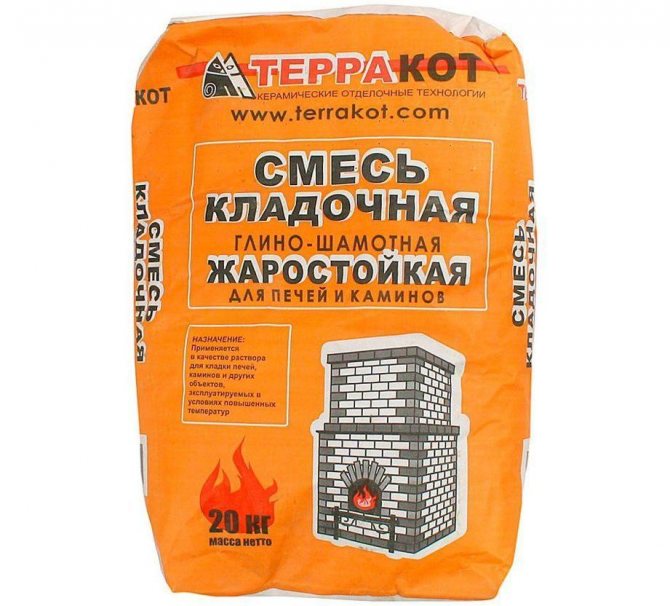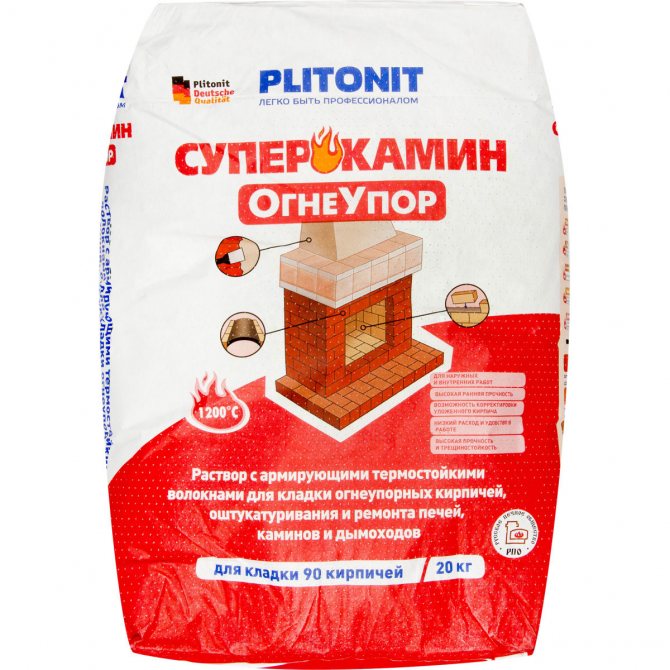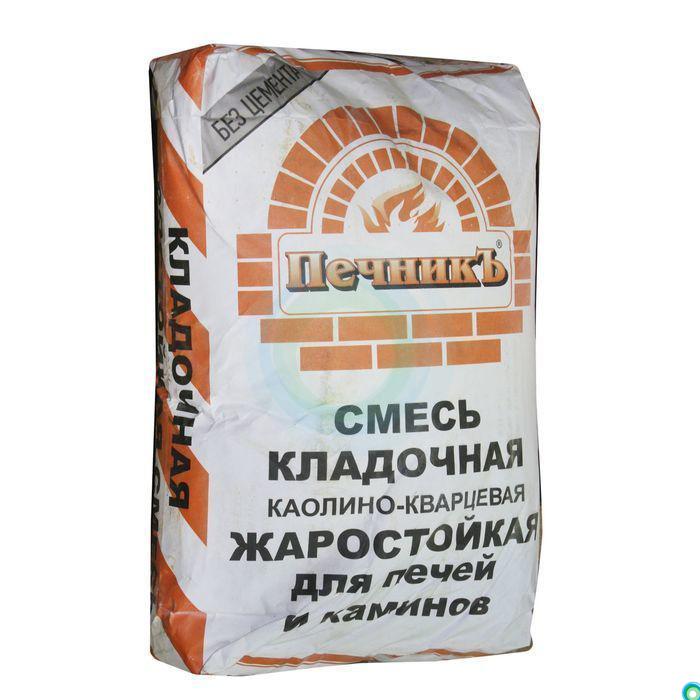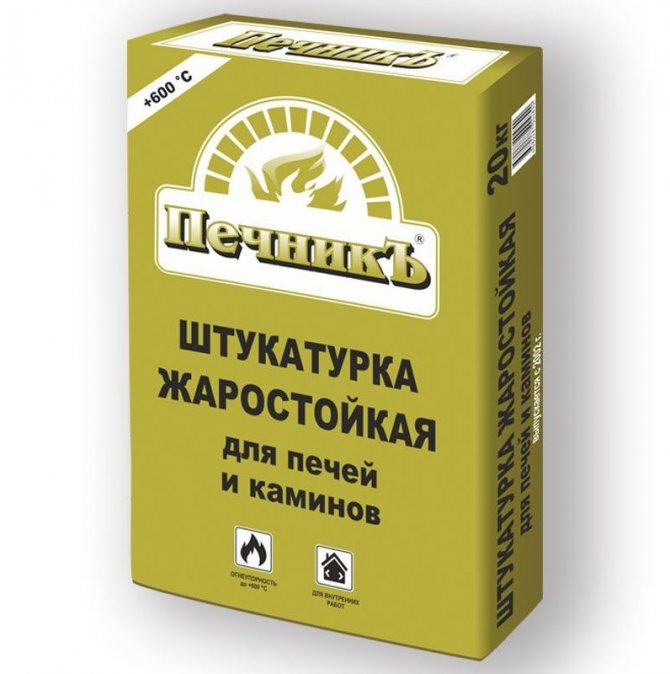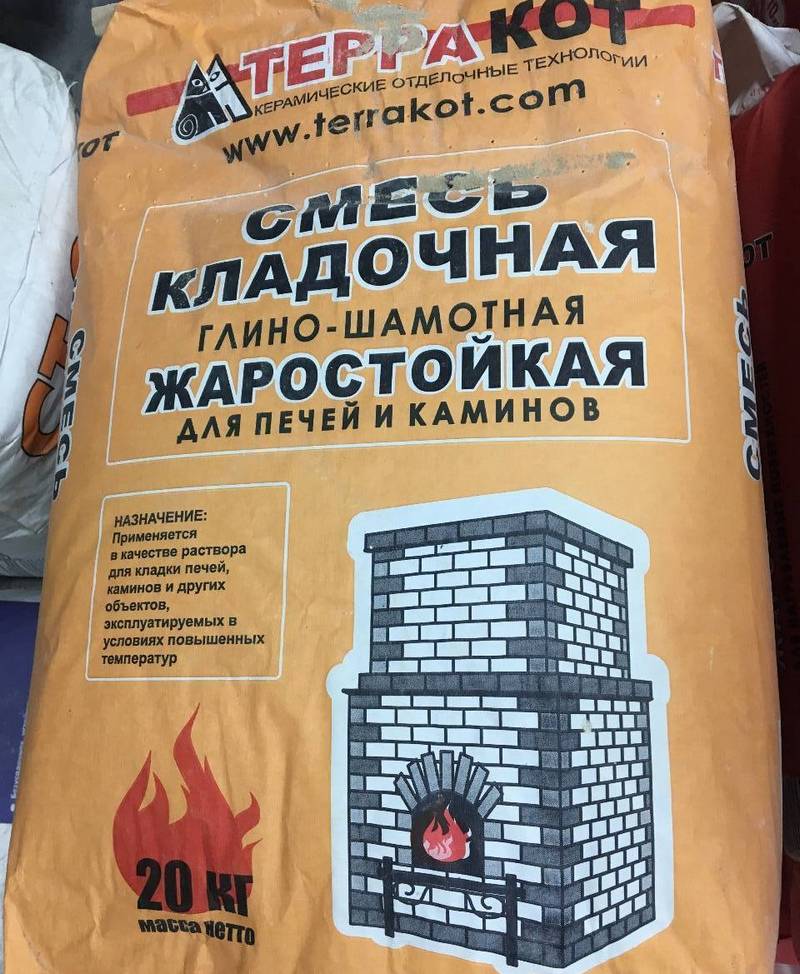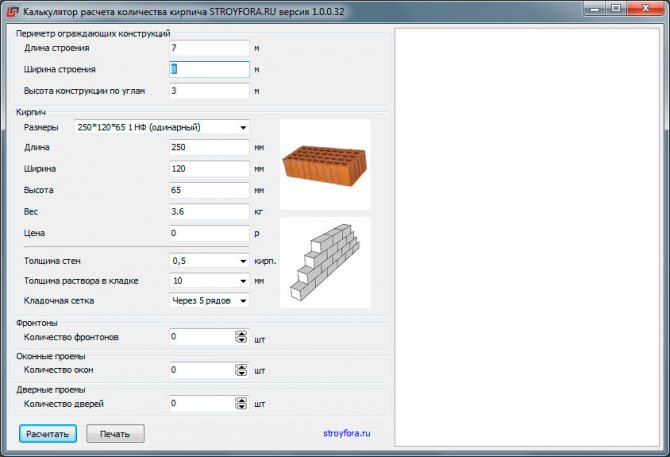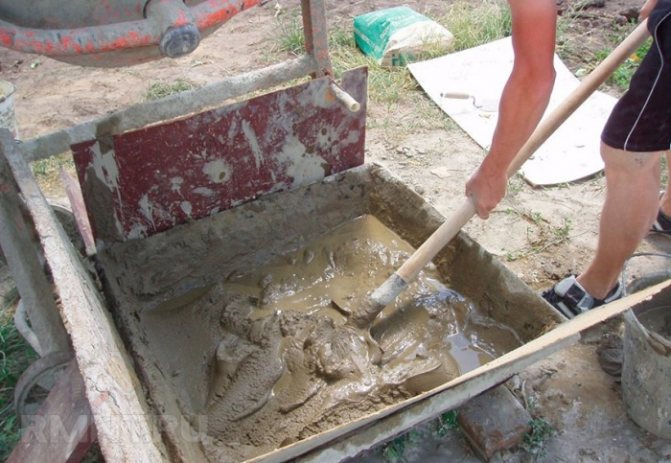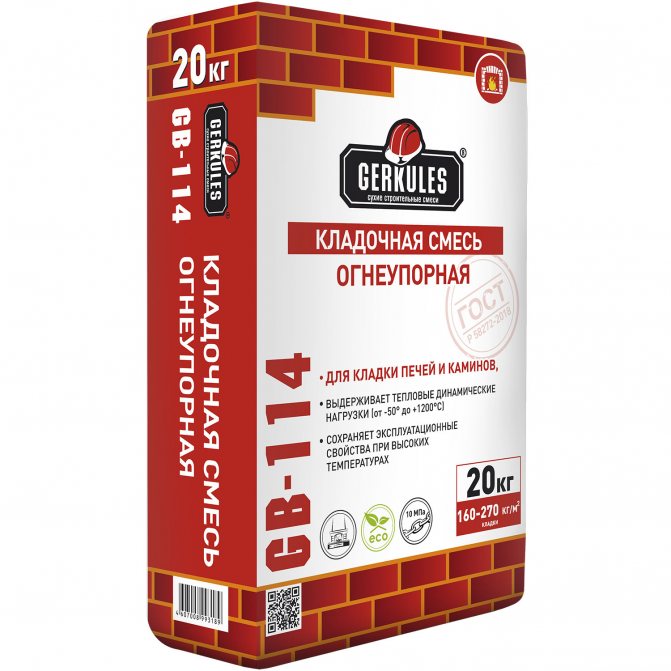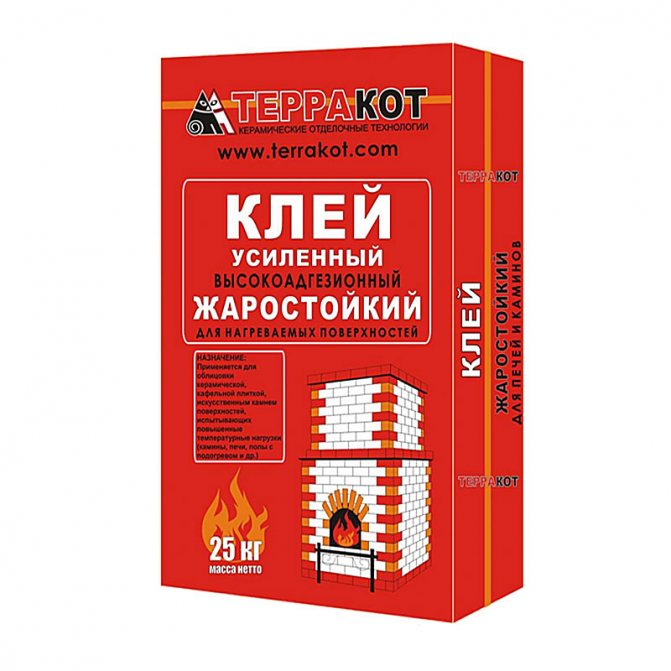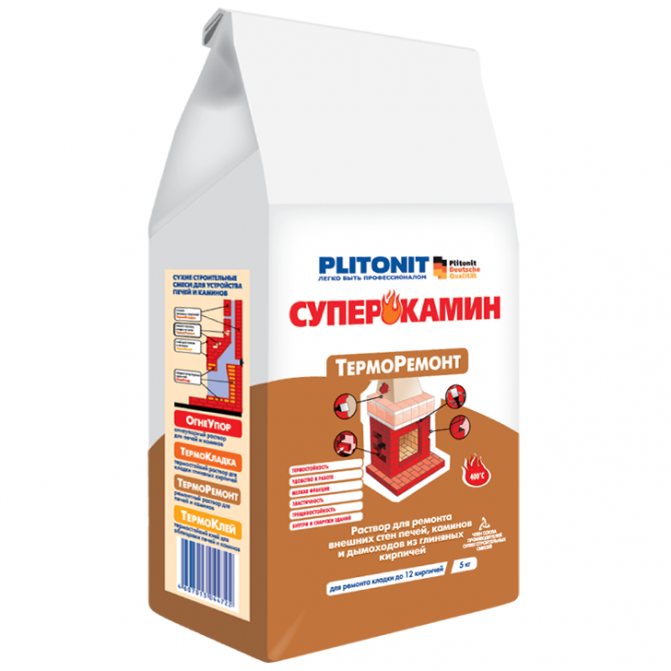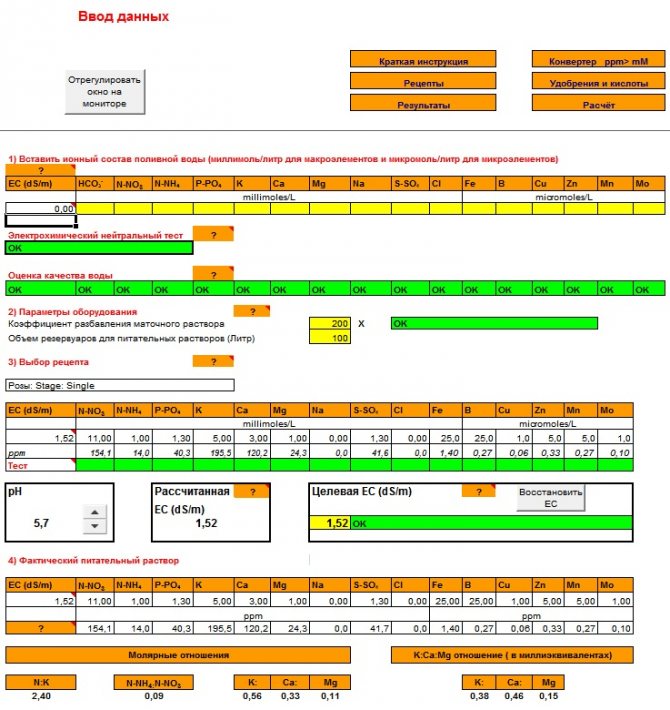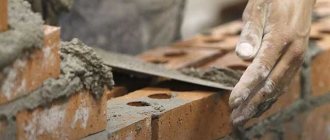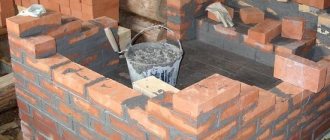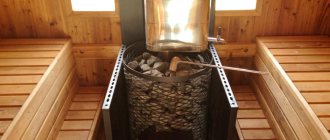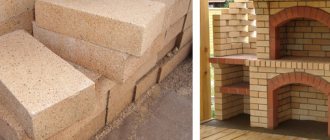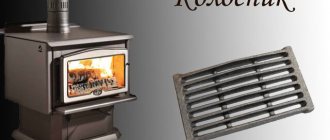Specifications
Fireclay fireclay is fired in special drum furnaces at a very high temperature. During processing, all moisture will evaporate from it. As a result, it becomes like a stone. At the final stage, pieces of clay are ground in mills to fine or coarse grains. According to the regulations, fireclay clay must have the following characteristics:
- moisture absorption - about 7.8%;
- grain size - 1.9 mm on average;
- moisture content - no more than 5%;
- fire resistance - 1530-1839 C.
The main advantage of chamotte clay is that it does not shrink. Consequently, masonry joints and plaster do not crack when dry.
Considering the technical characteristics of chamotte clay for plastering the furnace, the following should be noted:
- The grain size corresponds to two millimeters.
- High-fire fireclay absorbs no more than 10% moisture, and low-fire no more than 25% moisture.
- The maximum temperature that the material can withstand is 1850C.
- The moisture content of quality material does not exceed 5%.
When determining the required amount of material, you should know:
- A standard clay package of 20 kg is enough to stack 30 bricks.
- For 1 m3 of masonry, you should purchase 100 clay.
- The solution, prepared in strict compliance with the technology, becomes absolutely solid after 24 hours, provided that the air temperature does not drop below 10C.
Determining the quality of the clay
The main indicator is fat content. Distinguish between oily and skinny clay. The first, when dried, significantly decreases in volume and cracks, and the second crumbles.

Clay can be oily and skinny
Immediately, we note that there is no strictly defined ratio of sand and clay to obtain a good solution. The proportions are determined experimentally, by selection depending on the fat content of the breed.
You can determine the fat content of clay rock in the following way. Roll up the rope of clay, assuming a thickness of 10-15 mm and a length of 15-20 cm. Wrap them in a wooden form with a diameter of 50 mm. If the clay is oily, then the tourniquet is stretched gradually, without cracking. Normal provides a smooth stretch of the rope and breaks, reaching a thickness of 15–20% of the original diameter.
How to knead correctly
This material is sold in hardware stores, usually under the name kaolin. The most popular is dark chamotte clay. For stoves and fireplaces, or rather, for their masonry, it fits just perfectly, repeating the color of the brick. Plastering is often done with a light cream or white kaolin composition.
- The powder is poured into some suitable container.
- Warm water is poured from above. After that, the clay must be left to infuse for three days. This will increase the plastic properties of the fired material. The store sells specially prepared clay, which does not require three days of infusion. However, such material is more expensive.
- Next, the clay is thoroughly mixed. To obtain the desired consistency, you can add both a little clay and water to the mixture. This will not affect the quality of the finished solution.
After three days, the clay is thoroughly mixed with water.
Optimal proportions of ingredients for solution preparation
Depending on the properties of the clay used, the ratio of ingredients in the solution can be completely different.So, to prepare a mixture of lean clay requires a decrease in the amount of sand in the solution. Oily clay requires a 2-fold increase in the proportion of sand, which should also be taken into account. The best ratio of clay to sand in a mortar is 1: 1.
To obtain a strong and durable structure, the mortar should be prepared according to the following scheme: mix 10 kg of clay, 1 kg of cement and 150 g of salt. Although it is quite enough to choose high-quality materials and mix them in the correct ratio, even without the use of additional impurities.
How to make masonry mortar
If clay is needed for the construction of a stove or fireplace, quartz chamotte sand should be added to it in a 1x2 ratio. Normal mixing is not recommended. The fact is that simple sand has a higher coefficient of expansion than chamotte clay. Therefore, it is completely unsuitable for laying stoves. When using it later, during the operation of the furnace, cracks may appear in the seams.
River sand for fireclay solution is also not suitable. It does not provide the proper level of adhesion to all elements. In addition to chamotte sand, it is imperative to add a little PVA construction glue to the present clay. Sometimes a little cement is poured into the solution to increase its strength. However, in this case, the level of the maximum allowable temperature inside the oven decreases.
Often masonry mortar is kneaded using a different technology. In this case, one part of chamotte and blue clay and 4 parts of refractory sand are used. In this case, a very plastic and high-quality composition is obtained.
We suggest that you familiarize yourself with: Semi-dry floor screed: detailed step-by-step instructions
The ability to withstand high temperatures is what makes fireclay clay different. The use of solutions based on it, in addition, allows you to assemble very strong structures. Chamotte compositions are used, however, only when laying various kinds of furnace equipment made of refractory bricks. They are not suitable for regular red. The reason is the same difference in the coefficient of thermal expansion. Plain bricks are laid on plain clay mixed with sand.
The finished fireclay mortar should slide freely from the trowel without getting dirty. Of course, the presence of lumps, clots and foreign inclusions in the mixture is not allowed.
Fat Assessment Methods
When scooping up with a shovel, the solution should not spread and slide well from the surface. If necessary, the thickness of the mortar can be adjusted during the laying process.
- From clay (0.5 l) and a small amount of water, you need to prepare a dense dough. The clay should start to stick to your hands. After that, from the resulting mass, you need to mold 2 balls (50 mm in diameter), one of which is flattened into a pancake (100 mm in diameter), and leave to dry for 3 days. If the samples are cracked, therefore the clay is too oily, sand is poured onto it. If cracking does not appear, and as a result of falling from a meter height, the spherical lump does not split, then a solution is made from such a mass. In the case when the surface of the ball does not crack, but it breaks as a result of a fall, you need to add a more oily clay to the original. Additives are added to the original in small portions, and the finished material, after the next application of clay or sand, is checked again by similar testing until the required properties are obtained.
- Clay (3 l) is soaked in water in a deep bowl, mixed and the lumps are removed with a wooden spatula. If the mixture completely covers the shoulder blade, this indicates that it is oily, and sand is poured into the mixture. If the clay dough covers the shoulder very thinly, then it requires the addition of a more oily clay. And if lumps remain on the wooden spatula, then the clay does not need any changes and is considered ready for mixing the solution.
- Of the presented methods for determining fat content, this is the most accurate. As in the first method, the clay (0.5 l) is mixed with water until it becomes a dense dough. After kneading, a ball (50 mm in diameter) is also molded from it, which is placed between two boards. The boards are slowly compressed until cracking occurs on the ball. Ready clay is considered when cracks appear when the ball decreases by a third of its diameter, a building mixture is prepared from it. If the ball cracks earlier, then this mass is lean, and fatter clay is added to it. If later, the clay is diluted with sifted sand.
The strength of a clay mortar can be increased by introducing cement or salt additives into it. Table salt is used, and it is added at the rate of 100-250 grams per bucket of clay solution.
Now, from the previously prepared dough, you need to roll out a clay stick (15 mm thick and 200 mm long) and twist it around a long cylinder (50 mm in diameter). The dough is considered normal when small even cracks appear at the folds. The break points of such clay ropes are about 20% less than the initial diameter. If the dough does not crack, and the breaks have sharp ends, then the clay is oily. Skinny clay in places of bends forms a large number of breaks and uneven cracks. The loam must be brought to its normal state by mixing it with greasy clay or sand, depending on whether it is skinny or greasy, checking it each time in the way described above.
Using any of these methods, the proportion is determined in which sand should be poured into the initial mass for mixing the solution or diluted with clay of increased fat content, and it is taken into account that it is better to make a more oily solution. It will give more cracks, which can be repaired with a mixture of lower fat content in the future. And in the case of skinny clay, the masonry of the stove may not be strong enough.
Types of chamotte clay
A solution of refractory clay is used in cases where it is required to obtain a perfectly flat surface. In the process of work, corners and a special profile are necessarily used. Several profiles installed on one wall help to achieve an absolutely even plaster. During the installation process, it is recommended to use a plumb line or a building level. The corners are used to obtain smooth edges, they are glued directly to the plane.
To get a perfectly flat surface, you should use the rule. It is fixed across the vertical profiles so as to achieve simultaneous contact of all beacons horizontally.
When installing beacons, you should also pay attention to the level of extension of the combustion door and ashtray. The level of the profiles and doors must match so that the surface is smooth, without protrusions and depressions.
Refractory clay is often used to make decorative items. These can be tiles, figurines and even household utensils. Plasticity of such clay is given by special components added to the composition.
Fireclay can be used to prepare a high-quality mortar for laying stoves and plastering various surfaces. When deciding how to plaster the furnace with fireclay clay, the exact observance of all technologies allows you to independently perform the entire process from preparing the solution to applying it to the surface.
We suggest that you familiarize yourself with: How to prepare clay for laying a stove
In this case, the solution is prepared a little differently. Its composition should be as follows:
- Portland cement - 1 tsp;
- fireclay clay - 2 hours;
- quarry sand - 7 hours
Water is added in such an amount that the finished solution acquires the consistency of sour cream. Since fired clay has a much lower plasticity than ordinary clay, the plaster layer from it must be strengthened with a special metal mesh.The solution is applied in the usual way - with a spatula.
At the moment, in hardware stores, you can buy two main types of this material. Plain fired clay is made from kaolin. The second variety is made from rejected fireclay bricks. It is simply crushed into pieces, and then ground into powder of various grain sizes. Distinguishing the first variety from the second is not too difficult.
Methods for checking the quality of clay mortar
Before preparing the mixture, you need to determine the proportions of the components depending on the fat content of the selected clay, this will help to avoid problems in the future. When producing a large amount of material, it can be extremely difficult to correct errors.
To determine the fat content of the main ingredient, you must do the following:
- A little clay (about 1 kg or one liter plastic jar) is thoroughly cleaned. To do this, you can pick out large debris with your hands, and to remove the remaining contaminants, you will need to soak the substance in water several times. The liquid is constantly drained to remove all slurry.
- The resulting mass with a normal structure is divided into 5 equal parts: nothing is added to the first part, to the second - 25% of sifted sand, to the third - 50%, to the fourth - 75%, to the fifth - 100%.
- Each element is mixed separately. Water is added in small amounts until a pasty consistency is obtained. The readiness of the solution can be judged by whether the mixture sticks to the fingers: if not, then further mixing is not required.
After the experimental batch of the composition is ready, it must be tested.
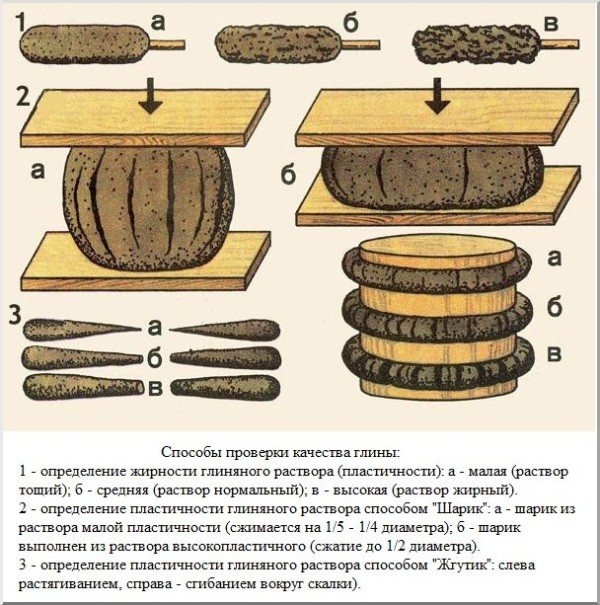

The fat content of the clay is determined by the plasticity of the samples.
Method 1
This technology is not particularly difficult. Each of the five parts is rolled into a small ball and kneaded into a cake. This is easily done by placing it in the center of your palm and pressing down with the fingers of your other hand. All the resulting cakes are marked with the appropriate pieces of paper, which indicate the proportions of sand.
It will take 2-3 days for the fragments to dry. Initially, a visual inspection is carried out: the cake should not have cracks and should not break when squeezed. If you drop it on the floor, then it should remain intact. Based on the results of the experiment, the correct ratio of sand and clay is determined.
Method 2
Balls with a diameter of about 3 cm are rolled, each of which is placed between two carefully rounded boards. Gradually, without undue effort, pressure is performed, the result is periodically checked. If the ball immediately began to crack, then this is a skinny mixture, if cracking occurred when squeezed in half - the composition is too oily. The optimal variant of the ratio of the components is when most of the ball will flatten and not collapse.


Checking the fat content of the composition by squeezing a clay ball
There are other ways, but the general principle is the same for everyone.
Refractory brick
The preparation of a mortar from chamotte clay for laying furnaces is carried out by analogy with plaster mixtures, the methods of application are also similar, which gives a big plus to the material.
Chamotte mixture is suitable for sculptural work and decoration, for the construction of stoves and fireplaces. Products become durable due to the evaporation of moisture during the drying process of the clay composition. The result is a high-strength, high-temperature resistant material.


A feature of chamotte is the following:
- It does not crumble when exposed to high temperatures.
- The material is resistant to environmental influences.
- The original form remains unchanged over time.
For the manufacture of this popular building material, fireclay is also often used. The method of using the kaolin mixture when laying stoves and fireplaces was discussed by us above.Refractory bricks, as you remember, are laid exclusively on fireclay mortar. The result is a structure that can withstand temperatures up to 1600 ° C.
Since fireclay bricks are much more expensive than ordinary bricks, they are most often used for the manufacture of only those parts of the stove or fireplace that are in direct contact with the fire: furnaces, chimneys. It is also used to make all sorts of production plants for the metallurgical, chemical and manufacturing industries. These can be boilers, blast furnaces, fuel chambers.
We invite you to familiarize yourself with: Wood-burning stove for the Varvara bath
Advantageous properties of clay
Refractory clay has some advantage over other materials due to the following characteristics:
- Long service life. A solution of chamotte clay does not crack, does not crumble and keeps its original shape for a long time.
- High adhesive properties, due to which the material adheres perfectly to any surface.
- Water vapor permeability.
- Ability to withstand strong enough heat.
- Safety and environmental compliance.
Clay preparation steps
It is very important for home craftsmen to know how to prepare fireclay clay for laying stoves. To do this, you can use the following scheme:
- Take a package of powder and pour it into a previously prepared container.
- The powder is poured with water and left to swell for three days.
- After this time, water is added again and the clay is mixed at the same time. The process continues until a homogeneous mass is obtained.
- In some cases, the addition of sand is allowed.
In the process of working with clay, it is necessary to constantly stir the solution, the quality of work depends on this. In addition, it is important to pay attention to the consistency of the solution, it is recommended to add water to a too thick composition, and powder to a liquid one. It is especially important to fulfill this condition when laying a furnace using refractory clay.
The amount of water in the solution plays an important role: the dry composition crumbles and crumbles, the liquid one flows down the working surface. Therefore, it is very important to know how to dilute fireclay clay for laying furnaces. When calculating the water used, it should be borne in mind that a solution of normal consistency resembles thick sour cream.
List of materials and tools
Tools:
- shovel;
- a container for soaking and stirring (in some cases, an additional container for mixing is used);
- a sieve with a mesh size of 1.5 mm;
- Master OK;
- bucket;
- wooden spatula;
- scoop.
Materials:
- Pure soft water. To mix the mortar, the number of bricks is taken to the volume of water in liters in a proportion of about 100/20.
- Finely sifted sand. Pass the sand through a sieve with a mesh size of 1.5 mm.
- High quality clay. There are several methods for assessing fat content, of which we will consider the main ones.

